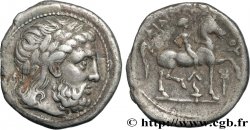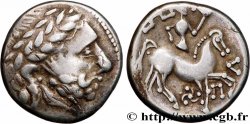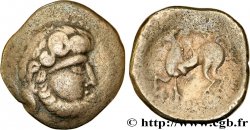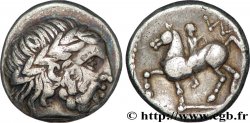bga_309122 - DANUBIAN CELTS - IMITATIONS OF THE TETRADRACHMS OF PHILIP II AND HIS SUCCESSORS Tétradrachme “au W”
Not available.
Item sold on our e-shop (2017)
Price : 450.00 €
Item sold on our e-shop (2017)
Price : 450.00 €
Type : Tétradrachme “au W”
Date: c. IIe-Ier siècles AC.
Mint name / Town : Atelier indéterminé
Metal : silver
Diameter : 23,50 mm
Orientation dies : 7 h.
Weight : 13,13 g.
Rarity : R3
Coments on the condition:
Exemplaire sur un flan ovale bien centré des deux côtés. Très belle tête de Zeus au droite. Revers stylisé mais encore de bonne facture. Très jolie patine de collection ancienne avec des reflets dorés
Catalogue references :
Predigree :
Exemplaire n° 43 de MONNAIES 59
Obverse
Obverse legend : ANÉPIGRAPHE.
Obverse description : Tête barbue et laurée de Zeus à droite.
Reverse
Reverse legend : W.
Reverse description : Cavalier au pas à gauche.
Commentary
Nous pourrions avoir affaire à un prototype du type au cavalier au W. Au droit , la tête de Philippe est encore de bon style. Seule la couronne de laurier proéminente permet de savoir que nous sommes en présence d’une imitation au droit. Pour le revers, il est plus difficile de distinguer un prototype. Nous avons l’impression que le graveur a simplement transposé le type classique à gauche. Seule la lettre du revers (W ou VV) permet d’identifier le type.
We could be dealing with a prototype of the type with the rider in the W. On the obverse, the head of Philip is still in good style. Only the prominent laurel wreath lets us know that we are in the presence of an imitation on the obverse. For the reverse, it is more difficult to distinguish a prototype. We have the impression that the engraver simply transposed the classic type to the left. Only the letter on the reverse (W or VV) allows us to identify the type
We could be dealing with a prototype of the type with the rider in the W. On the obverse, the head of Philip is still in good style. Only the prominent laurel wreath lets us know that we are in the presence of an imitation on the obverse. For the reverse, it is more difficult to distinguish a prototype. We have the impression that the engraver simply transposed the classic type to the left. Only the letter on the reverse (W or VV) allows us to identify the type








 Report a mistake
Report a mistake Print the page
Print the page Share my selection
Share my selection Ask a question
Ask a question Consign / sell
Consign / sell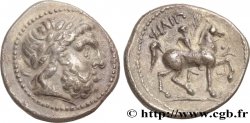
 Full data
Full data
